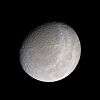Fenrir (moon)
| Discovery[1] | |
|---|---|
| Discovered by | Scott S. Sheppard, David C. Jewitt, Jan Kleyna |
| Discovery site | Subaru, Gemini, Keck |
| Discovery date | 2004 |
| Designations | |
| S/2004 S 16[1][2] | |
| Orbital characteristics[3] | |
| 22,454,000 km | |
| Eccentricity | 0.1363 |
| 1260.35 d (3.45 yr) | |
| 146.614° | |
| Inclination | 164.955° |
| 330.95° | |
| 120.264° | |
| Satellite of | Saturn |
| Physical characteristics | |
| Dimensions | ~4 km[4] |
| Albedo | 0.04 (assumed)[1] |
| 25.0[4] | |
|
| |
Fenrir (/ˈfɛnrɪər/ FEN-reer) or Saturn XLI (provisional designation S/2004 S 16) is a natural satellite of Saturn. Its discovery was announced by Scott S. Sheppard, David C. Jewitt, Jan Kleyna, and Brian G. Marsden on May 4, 2005, from observations taken between December 13, 2004, and March 5, 2005. Fenrir has an apparent magnitude of 25,[4] making it one of the faintest known moons in the Solar System, and was discovered using some of the largest telescopes in the world.[1] It is even too dark to be observed by the Cassini spacecraft in orbit around Saturn where it never gets brighter than ~17th magnitude. Fenrir was named after Fenrisulfr, a giant wolf from Norse mythology, father of Hati and Skoll, son of Loki, destined to break its bonds for Ragnarök.
Fenrir is about 4 kilometres in diameter,[4] and orbits Saturn at an average distance of 22,454 Mm in 1260 days, at an inclination of 163° to the ecliptic (143° to Saturn's equator) with an eccentricity of 0.136. The Fenrian orbit is retrograde: it orbits Saturn in a direction opposite to the planet's spin, suggesting that this irregular moon was captured by Saturn.[5]
References
- 1 2 3 4 Daniel W. E. Green (2005-05-04). "IAUC 8523: NEW Sats OF SATURN". International Astronomical Union.
- ↑ Daniel W. E. Green (2007-04-05). "IAUC 8826: Sats OF JUPITER, SATURN". International Astronomical Union.
- ↑ Jacobson, R.A. (2007) SAT270, SAT271 (2009-04-03). "Planetary Satellite Mean Orbital Parameters". JPL/NASA. Retrieved 2009-07-30.
- 1 2 3 4 Scott S. Sheppard. "Saturn's Known Satellites". Carnegie Institution (Department of Terrestrial Magnetism). Retrieved 2009-07-30.
- ↑ David C. Jewitt. "Twelve New Moons for Saturn - 2005 May 03". University of Hawaii (Institute for Astronomy). Archived from the original on September 18, 2009. Retrieved 2009-07-30.
External links
- Saturn's Known Satellites (by Scott S. Sheppard)
- MPEC 2005-J13: Twelve New Satellites of Saturn May 3, 2005 (discovery and initial ephemeris)

